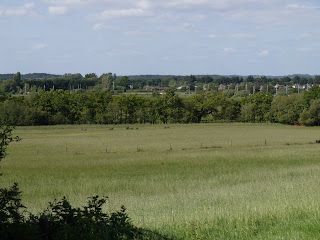Norden Station
This walk begins in the car park at Norden station near Corfe Castle, where most other people were catching the steam train to Swanage. You leave the car park, cross the road and head north (appropriately) to a locality called, for some reason, Scotland.
The path leads across alternating fields and woodland. On the edge of the first section of wood and in the next large field we saw these curious wooden structures, which seemed rather like a rustic tennis umpire's chair. We still have no idea as to their purpose; on hearing a pheasant, we wondered if they may have something to do with pheasant rearing.
At Scotland Farm, you turn left (i.e. west) and head along a pleasant lane, then a track, with views across open land to Corfe Castle.
You eventually reach the busy A351 and continue, after crossing the disused section of the railway line, across Norden Heath to reach the entrance to the Blue Pool. This is an old clay pit which has - obviously - filled with water which has turned blue. It is surrounded by nicely arranged gardens, paths and places to sit, and a tea room. The Pool itself is very pretty.
The story of ball clay mining in the Purbecks can be discovered at the Purbeck Mineral and Mining Museum near Norden Station - or from its informative website. There is evidence of clay mining in the
area from Roman times, but two fashions gave it a massive impetus: the introduction of tobacco in the 16th century created a demand for clay pipes and the fashion for tea drinking in the 18th century which led to the growth of Staffordshire china making. Josiah Wedgwood regarded Purbeck Blue Clay as the best in the world for making his wares.
On leaving the Blue Pool, we soon joined a path back to Corfe which runs through some delightful woodland parallel with the Purbeck ridge. Further evidence of clay mining could be seen on all sides. This in fact was the return leg of an earlier walk from Corfe along the ridge which we did last November. After a while you climb up through a campsite towards the ridge, with nice views to the west, away from the tents and camper vans.
You then continue along a line parallel to the ridge, but higher up, to skirt Corfe Castle, taking yet another picture.
The final leg of the walk follows the Purbeck Way from the Corfe Visitor Centre alongside the railway back to Norden. I was pleased to be offered an opportunity for an action shot of the train as it came past. I was amused to see that it was pulled by a streamlined Battle of Britain class locomotive (a "flat top") which I recorded in my notebook when I was a boy. 34070 Manston for the record, named after an airfield in Kent.
Conditions: 14 degrees or so, sun, quite windy.
Distance: 6 miles or so, including the tour round the Blue Pool.
From: walkingworld.com [ID 3771].
Map: Explorer OL15 (Purbeck and South Dorset).
Rating: three and half stars. Interesting and varied.
Flower of the day
I can't recollect ever noticing this Dove's-foot Cranesbill before. The tiny flowers are very close to the ground, but provided an intense spot of colour beside the path through one of the areas of heathland.




















































